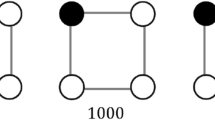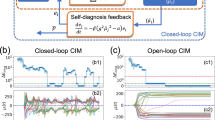Abstract
We study the relation between the Ising problem Hamiltonian parameters and the minimum spectral gap (min-gap) of the system Hamiltonian in the Ising-based quantum annealer. The main criterion we use in this paper to assess the performance of a QA algorithm is the presence or absence of an anti-crossing during quantum evolution. For this purpose, we introduce a new parametrization definition of the anti-crossing. Using the Maximum-weighted Independent Set (MIS) problem in which there are flexible parameters (energy penalties J between pairs of edges) in an Ising formulation as the model problem, we construct examples to show that by changing the value of J, we can change the quantum evolution from one that has an anti-crossing (that results in an exponential small min-gap) to one that does not have, or the other way around, and thus drastically change (increase or decrease) the min-gap. However, we also show that by changing the value of J alone, one can not avoid the anti-crossing. We recall a polynomial reduction from an Ising problem to an MIS problem to show that the flexibility of changing parameters without changing the problem to be solved can be applied to any Ising problem. As an example, we show that by such a reduction alone, it is possible to remove the anti-crossing and thus increase the min-gap. Our anti-crossing definition is necessarily scaling invariant as scaling the problem Hamiltonian does not change the nature (i.e., presence or absence) of an anti-crossing. As a side note, we show exactly how the min-gap is scaled if we scale the problem Hamiltonian by a constant factor.














Similar content being viewed by others
References
Albash, T.: Role of non-stoquastic catalysts in quantum adiabatic optimization. Phys. Rev. A 99, 042334 (2019)
Albash, T.: Private Communication (2019)
Albash, T., Lidar, D.A.: Adiabatic quantum computation. Rev. Mod. Phys. 90, 015002 (2018)
Altshuler, B., Krovi, H., Roland, J.: Anderson localization makes adiabatic quantum optimization fail. Proc. Natl. Acad. Sci. USA 107, 12446–12450 (2010)
Amin, M.H.S., Choi, V.: First order phase transition in adiabatic quantum computation. Phys. Rev. A 80(6), (2009) arXiv:0904.1387 [quant-ph]
Boros, E., Hammer, P.L.: Pseudo-Boolean optimization. Discret. Appl. Math. 123, 155–225 (2002)
Choi, V.: Different adiabatic quantum algorithms for the NP-complete exact cover problem. Proc. Natl. Acad. Sci. USA 108(7), E19–E20 (2011)
Choi, V.: Different adiabatic quantum algorithms for the NP-complete exact cover and 3SAT problem. Quantum Inf. Comput. 11, 0638–0648 (2011). arXiv:1010.1221 [quant-ph]
Choi, V.: Minor-embedding in adiabatic quantum computation: I. The parameter setting problem. Quantum Inf. Process. 7, 193–209 (2008)
Choi, V.: XX-Driver Hamiltonian and driver architecture in adiabatic quantum optimization. In: preparation (2019)
Dickson, N.G., Amin, M.H.S.: Does adiabatic quantum optimization fail for NP-complete problems? Phys. Rev. Lett. 106, 050502 (2011)
Dickson, N.G.: Elimination of perturbative crossings in adiabatic quantum optimization. New J. Phys. 13, 073011 (2011)
Farhi, E., Gosset, D., Hen, I., Sandvik, A.W., Shor, P., Young, A.P., Zamponi, F.: The performance of the quantum adiabatic algorithm on random instances of two optimization problems on regular hypergraphs. Phys. Rev. A 86, 052334 (2012)
Fujii, K.: Quantum speedup in stoquastic adiabatic quantum computation. arXiv:1803.09954 (2018)
Hastings, M.B., Freedman, M.H.: Obstructions to classically simulating the quantum adiabatic algorithm. arXiv:1302.5733 (2013)
Hormozi, L., Brown, E.W., Carleo, G., Troyer, M.: Nonstoquastic Hamiltonians and quantum annealing of an ising spin glass. Phys. Rev. B 95, 184416 (2017)
Jarret, M., Jordan, S.P., Lackey, B.: Adiabatic optimization versus diffusion Monte Carlo methods. Phys. Rev. A 94, 042318 (2016)
Knysh, S.: Zero-temperature quantum annealing bottlenecks in the spin-glass phase. Nat. Commun. 7, 12370 (2016)
Muthukrishnan, S., Albash, T., Lidar, D.A.: Tunneling and speedup in quantum optimization for permutation-symmetric problems. Phys. Rev. X 6, 031010 (2016) arXiv:1511.03910 [quant-ph]
Qureshi, M.A., Zhong, J., Mason, P., Betouras, J.J., Zagoskin, A. M.: Pechukas–Yukawa formalism for Landau–Zener transitions in the presence of external noise (2018) arXiv:1803.05034v2
Stein, W.A. et al.: Sage mathematics software (Version 8.0). The Sage Development Team (2009). http://www.sagemath.org
Wilkinson, M.: Statistical aspects of dissipation by Landau–Zener transitions. J. Phys. A Math. Gen. 21, 4021–4037 (1988)
Wilkinson, M.: Statistics of multiple avoided crossings. J. Phys. A Math. Gen. 22, 2795–2805 (1989)
Acknowledgements
The author is grateful to Tameem Albash for his generous sharing/update knowledge of the current state of art the QA algorithm, especially in regard to topics including the min-gap estimation, anti-crossing and perturbative crossing, quantum tunneling; and for his many comments on this paper; and for the permission to use the loop gadgets example (including Fig. 2) he constructed in this paper. Special thanks also go to Daniel Lidar, for the invitation to resume the AQC research, and for his comments on this paper. I would also like to thank Adrian Lupascu and his QEO group members for the comments. The author also gratefully acknowledges the use of the Sage Mathematics Software [21] for the computation of the eigenvalues and plotting the graphs in this paper. The research is based upon work partially supported by the Office of the Director of National Intelligence (ODNI), Intelligence Advanced Research Projects Activity (IARPA), via the U.S. Army Research Office contract W911NF-17-C-0050. The views and conclusions contained herein are those of the authors and should not be interpreted as necessarily representing the official policies or endorsements, either expressed or implied, of the ODNI, IARPA, or the U.S. Government. The U.S. Government is authorized to reproduce and distribute reprints for Governmental purposes notwithstanding any copyright annotation thereon.
Author information
Authors and Affiliations
Corresponding author
Additional information
Publisher's Note
Springer Nature remains neutral with regard to jurisdictional claims in published maps and institutional affiliations.
Rights and permissions
About this article
Cite this article
Choi, V. The effects of the problem Hamiltonian parameters on the minimum spectral gap in adiabatic quantum optimization. Quantum Inf Process 19, 90 (2020). https://doi.org/10.1007/s11128-020-2582-1
Received:
Accepted:
Published:
DOI: https://doi.org/10.1007/s11128-020-2582-1




